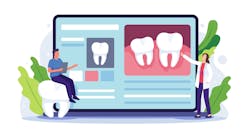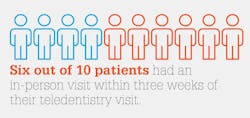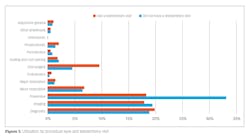As we continue to navigate the ongoing impacts of the COVID-19 public health emergency and look toward the future, the long-term benefits of telehealth for both providers and patients are becoming evident, including in oral health care. The value of teledentistry was discussed at length in the December 2021 Spotlight on Mobile and Teledentistry in Dental Economics.1 Value considerations for teledentistry include the ability to use technology to improve patient access to dental services at a cost that is affordable for patients and lowers overhead costs for dental practices.
This value proposition was demonstrated early in the COVID-19 pandemic, when in-person visits were limited and many dental providers incorporated teledentistry into their practices to ensure they could continue to help patients access care, triage their needs, and communicate about treatment recommendations. And while teledentistry was thought to improve access and reduce costs, research on it was limited—especially on the types of follow-up treatments provided after a teledentistry visit.
Related reading:
- Teledentistry ROI: Lessons learned in public health for private-practice dentists
- Teledentistry: Virtual visits save time and PPE
- The value teledentistry brings to dentists and their patients
To address this gap, CareQuest Institute for Oral Health—a leading national nonprofit focused on creating a more accessible, equitable, and integrated oral health system—looked at CDT code dental claims data on oral health outcomes in a sample of about 60,000 patients with in-person or teledentistry visits.
The results of that research2 indicate that teledentistry can increase access to oral health care and decrease costs, both now and after the pandemic.
1: Teledentistry care is well-suited to triage patients and maximize chair time
CareQuest Institute data show that teledentistry was a well-utilized and valuable tool for patient care during the height of the pandemic and led to timely in-personand virtual follow-up.
Of the survey sample, 3,562 (5.9%) patients had a teledentistry visit. Of those, 97% had follow-up in-person visits, most of which (60%) occurred within three weeks after their initial virtual visit. Follow-up care after a teledentistry visit primarily consisted of diagnostic and restorative services and less often consisted of preventive care. According to the data, six out of 10 individuals who had a teledentistry visit subsequently had a problem-focused evaluation at their next in-person visit.
Those who had a teledentistry visit were more likely to have restorative care (minor and major), diagnostic services, prosthodontic care, or an oral surgery or endodontic procedure at their first in-person visit than those who did not have a teledentistry visit (figure 1).
While less frequent, teledentistry stimulated the use of preventive care, such as oral hygiene instruction and nutritional counseling, during the virtual visit and caries risk assessment during follow-up. Providing services such as caries risk assessment, patient education, or setting self-management goals through teledentistry more often or even routinely allows for greater utilization of preventive care and empowers patients to better manage their oral health.
These findings demonstrate that providers can use teledentistry to successfully communicate with patients, triage patient needs, and plan in-person visits more efficiently. Importantly, triaging care through teledentistry allows strategic use of chair time to provide more definitive and involved procedures, such as oral surgery, endodontic procedures, and restorative care.
2: Teledentistry visits save money compared to in-person visits
Teledentistry also allows for cost savings, a key piece of providing value-based care. The CareQuest Institute study2 suggests cost savings of approximately3: Teledentistry benefits patients with less access to care
The study found teledentistry allowed individuals in rural areas to access dental care more easily. Rather than traveling long distances for preventive or simple diagnostic services, patients were able to receive restorative or other definitive treatments when they traveled to the dental office for in-person care. According to the research, teledentistry was more often used by individuals living in rural areas (13%) compared to those living in suburban (10%) or urban (6%) locations.
4: Dental professionals are ready to accept teledentistry
The study results presented above come on the heels of a CareQuest Institute report that builds on findings from three surveys of dental team members in Oregon and Washington during teledentistry implementation.3 These surveys explored how attitudes toward teledentistry changed over the course of six monthsas providers gained experience with virtual workflows and new software within their practices.
In the surveys, more than three-quarters of the providers believed that utilizing a teledentistry platform increased access to care for patients.
Approximately half of providers agreed that utilizing a teledentistry platform increased patient satisfaction and helped shorten patient wait times to get an appointment. Many agreed that using teledentistry can aid in providing accurate diagnoses, prescribing medication, and making referrals. Further, almost 85% of providers said dental professionals are ready to accept teledentistry as a care delivery method.
The survey results show that dental providers are open to teledentistry, and that it can play a crucial role in increasing access to care and improving quality of care.
5: Teledentistry can provide long-term benefits to providers and patients
These new pieces of research indicate that dental teams can use teledentistry to support comprehensive, integrated care that improves quality at a lower cost to the patient and the provider. Teledentistry is an excellent example of value-based care, as it has the potential to increase access to care less expensively.
Beyond the pandemic, teledentistry holds great promise to improve and increase access to dental care. Providers can use the modality to enable comprehensive, risk-based, and integrated care that improves quality at a lower cost.
Editor's note: This article appeared in the June 2022 print edition of Dental Economics magazine. Dentists in North America are eligible for a complimentary print subscription. Sign up here.
References
- Croley DW. The value teledentistry visits bring to dentists and their patients. Dental Economics. December 9, 2021. Accessed March 7, 2022. https://www.dentaleconomics.com/macro-op-ed/article/14213045/the-value-teledentistry-visits-bring-to-dentists-and-their-patients
- Heaton LJ, Thakkar-Samtani M, McLeod CD, Tranby EP. Teledentistry helps provide the right care at the right time. CareQuest Institute for Oral Health. February 2022. doi:10.35565/CQI.2022.2001 https://www.carequest.org/resource-library/teledentistry-helps-provide-right-care-right-time
- Crouch B, McLeod CD, Kelly A, Tranby EP. Oral health professionals are ready to accept teledentistry. CareQuest Institute for Oral Health. September 2021. doi:10.35565/CQI.2021.2042 https://www.carequest.org/resource-library/oral-health-professionals-are-ready-accept-teledentistry











